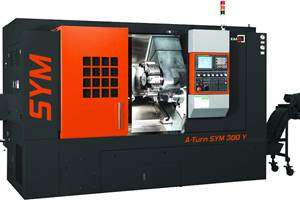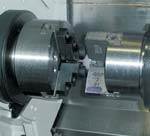Prototyping Productivity
A manufacturer of hermetic compressors proves out a new strategy based on multi-process machining.
For a high-volume manufacturer of consumer products, developing a new production process represents a challenging endeavor. Existing production levels must be maintained while phasing in new machine tools, and the organization must adapt simultaneously to changes in workflow and job assignments. Because new products are often developed concurrently with day-to-day production operations, successful manufacturers recognize the advantage of prototyping machining processes at the same time that they prototype parts.
One such manufacturer is Tecumseh Products Company (Tecumseh, Michigan), perhaps best known as a producer of gasoline engines and power trains for lawn equipment and recreational vehicles. Founded in 1930 by Ray W. Herrick, the firm’s business was initially focused on the production of automotive parts. By the end of World War II, however, Tecumseh had become an important manufacturer of compressors for mechanical refrigerators. Over the years, this segment of the firm’s business has expanded to include compressors for various types of cooling applications.
Today, the company has more than 30 principal locations in the United States and around the world. Manufacturing hermetic compressors for air conditioning and refrigeration products currently represents more than 60 percent of Tecumseh’s business, while engine and power train production accounts for approximately 33 percent. The company’s compressor products include small units for household refrigerators and dehumidifiers, as well as larger units for commercial air conditioning systems. Tecumseh also manufactures various types of pumps for industrial, commercial, agricultural and marine applications.
Given the key role of compressor production in the company’s success, maintaining an efficient and competitive manufacturing process is crucial. Demonstrating its commitment to adopt new manufacturing technologies and techniques, the company recently purchased a Mazak multi-process machine for operations at its Dundee Research Division (Dundee, Michigan). After investigating the machine’s capabilities at the Mazak National Technology Center (Florence, Kentucky), Tecumseh’s management team decided that the Integrex 300-IISY was well suited to the company’s needs. “Not only was this machine selected for R&D work, but also for technology evaluation,” says Michael Bourg, general manager of the firm’s development laboratory.
Part And Process
The Dundee facility has approximately 40 employees, including one CAD operator, one CAM operator and seven programmers. The company uses a solid-model programming system with Unigraphics software. The research division’s work includes machining compressor, engine, motor and pump components for testing purposes, as well as some that are used in new products. For this reason, the machine shop strictly produces short runs of parts that are subject to frequent design changes. In this type of environment, the multi-process machine’s abilities to complete parts in single setups and to switch rapidly from running one part program to the next are particularly advantageous.
The internal structure of a hermetic compressor is designed to retain tiny molecules of refrigerant gas. For this reason, the compressor’s main bearing must be machined to extremely close tolerances. Tecumseh engineers constantly develop new bearing designs to perform this function more efficiently, and a significant portion of the Dundee facility’s work involves developing and testing new versions of this part. The company’s recent experience in producing these prototypes suggests that the multi-process machine has great potential to enhance Tecumseh’s overall manufacturing scheme.
In the past, manufacturing these bearings required two lathe operations, two machining center operations and four inspection programs. This process involved multiple machine setups and a substantial amount of human intervention. The multi-process machine now enables the company to reduce this process to only one setup and one CMM operation. Pursuant to the acquisition of a new machine, Tecumseh’s CEO, Todd Herrick, established the ambitious goal of going from art to part in only 2 weeks. But the company now aims to exceed even these high expectations.
“With the Integrex we have achieved that goal and are now working toward a 1-week time frame,” says Mr. Bourg. In terms of efficiency, he says, “We’ve had a 60 to 70 percent reduction in our overall processing time for this component.” In addition to time saved, eliminating multiple setups has a positive impact on the products that Tecumseh develops. Besides substantially reducing human errors, it also avoids variations due to tolerance stackups. “This enables us to hold tighter tolerances and to produce higher-quality parts,” says Mr. Bourg.
Planning For The Future
While its research facility continues to evaluate the performance of the new machine, Tecumseh is prototyping production processes for potential applications throughout its manufacturing operations. Ultimately, the company’s management aims to create more efficient and flexible manufacturing operations that fully exploit the key advantages of this technology.
Proving out these new processes in a research environment certainly makes sense for large manufacturers such as Tecumseh that maintain multinational operations. But the company’s recent experience also suggests that a similar strategy is not beyond the reach of smaller manufacturers, particularly those who share the need for concurrent research, development and production. As metalworking firms that serve varied business segments increasingly adopt multi-process machines, it’s apparent that the justification for using this technology doesn’t necessarily depend on the relative scale of operations. Regardless of the quantity or type of parts produced, manufacturers widely consider this capability to represent an important competitive advantage.
Related Content
Kaast Machine Tools Updates Dual-Spindle Lathe
The A-Turn SYMCNC Dual-Spindle Lathe is now available in four different swing lengths, including 22.5", 24", 26.75" or 36".
Read MoreBuying a Lathe: The Basics
Lathes represent some of the oldest machining technology, but it’s still helpful to remember the basics when considering the purchase of a new turning machine.
Read MoreCNC Machine Shop Honored for Automation, Machine Monitoring
From cobots to machine monitoring, this Top Shop honoree shows that machining technology is about more than the machine tool.
Read MoreInside the Premium Machine Shop Making Fasteners
AMPG can’t help but take risks — its management doesn’t know how to run machines. But these risks have enabled it to become a runaway success in its market.
Read MoreRead Next
Merging Functions For Better Efficiency
By eliminating extra steps, a multi-process machine enables a medical manufacturer to streamline its production time and conserve shop space.
Read MoreThe Cut Scene: The Finer Details of Large-Format Machining
Small details and features can have an outsized impact on large parts, such as Barbco’s collapsible utility drill head.
Read More3 Mistakes That Cause CNC Programs to Fail
Despite enhancements to manufacturing technology, there are still issues today that can cause programs to fail. These failures can cause lost time, scrapped parts, damaged machines and even injured operators.
Read More
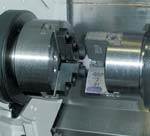


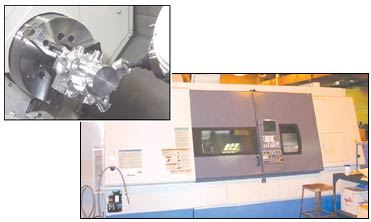
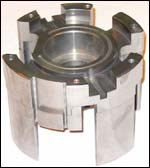













.png;maxWidth=300;quality=90)






